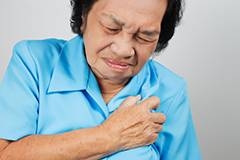Unique Heart Risks for Women
Medically Reviewed by Alan M. Blaker, MD
Not only do heart attacks in women exhibit with symptoms different from men, but women are different from men in the way some risk factors affect them.
“Most coronary heart disease risk factors affect men as well as women,” says McLeod Cardiologist Alan Blaker, MD. “Three risks unique to women are related to birth control pills, pregnancy, and menopause.”
SMOKING & BIRTH CONTROL PILLS
Smoking puts you at risk for almost every major health condition from cancer to cardiac issues. For women, smoking even 2 cigarettes a day increases the risk of heart disease. When a woman adds birth control pills to a smoking habit, risk rises into the very high range – especially if she’s over 35.
PREGNANCY
During pregnancy, about 5% of women suffer a condition known as preeclampsia (pree-e-KLAMP-see-uh). In addition to threatening the pregnancy, this condition is marked with a rise in blood pressure. Although the symptoms may disappear after the baby is delivered, the woman risks high blood pressure later in life. Preeclampsia itself is linked to a higher lifetime risk of heart attacks and heart disease.
MENOPAUSE
A number of changes occur in a woman’s body during menopause. Fats in the blood (triglycerides) increase. LDL (bad) cholesterol increases. HDL (good) cholesterol decreases as estrogen hormone diminishes. Bloods pressure starts to go up.
Women who experience early menopause from a hysterectomy (or naturally) are twice as likely to experience heart disease as other women their age.
Other Heart Risks More Predominant in Women…
MIGRAINES
Migraines tend to be more common among women than men. Women with migraines accompanied by flashes of light, auras or other visual side effects have a greater risk of heart disease.
BLOOD PRESSURE
High blood pressure is a warning sign of cardiovascular problems in men and women. Particularly in women, a blood pressure greater than 120/80 represent an increase heart disease risk.
WEIGHT
Excess weight puts strain on the heart. In women, weight presents two problems. First, “apple-shaped” people — those who carry most of their fat around the waistline – are at higher risk than “pear-shaped” people — those carrying their fat on the hips and thighs.
Second, the tendency to diet (unhealthily) – with weight bouncing dramatically up and down – can be a problem. The weight swings can lower HDL – the good cholesterol – increasing heart risk.
DIABETES
In women, diabetes presents a greater risk of heart disease than in men. Some studies found it doubles a woman’s risk of developing heart disease.
DEPRESSION
In addition to the depressed person along with their family and friends, the depressed person’s BODY feels the strain of this emotional state as well. A person with depression is 2-3 times more likely to develop heart disease and women are twice as likely to suffer depression than men.
FINAL THOUGHT
You’re not alone with these risks. Reportedly, more than 75% of women between the age of 40 and 60 have one or more of these risks.
You can work to control a number of these risks: First, quit smoking. Then, try to get regular exercise. In addition to helping control your weight, it can lower your blood pressure, decrease bad cholesterol, help control diabetes, and reduce stress.
Sources include: McLeod Health, American Heart Association, US Department of Health & Human Services, National Institutes of Health, European Society of Cardiology
-
McLEOD REGIONAL MEDICAL CENTER FLORENCE
843-777-2000 -
McLEOD DARLINGTON
843-777-1100 -
McLEOD DILLON
843-774-4111 -
McLEOD LORIS
843-716-7000 -
McLEOD SEACOAST
843-390-8100 -
McLEOD CHERAW
843-537-7881 -
McLEOD CLARENDON
803-433-3000



-
McLEOD REGIONAL MEDICAL CENTER FLORENCE
843-777-2000 -
McLEOD DARLINGTON
843-777-1100 -
McLEOD DILLON
843-774-4111 -
McLEOD LORIS
843-716-7000 -
McLEOD SEACOAST
843-390-8100 -
McLEOD CHERAW
843-537-7881 -
McLEOD CLARENDON
803-433-3000
 Find a Doctor
Find a Doctor  Locations
Locations  Services
Services 